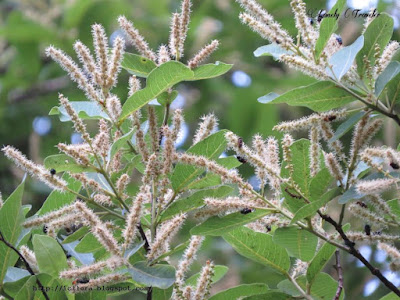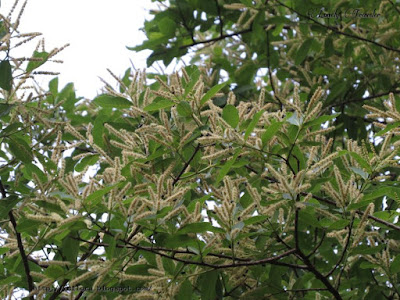| Common Name : | Arjun, Arjuna. |
| Binomial Name : | Terminalia arjuna |
| Family : | Combretaceae |
| Bangla Name : | Arjun (অর্জুন) |
| Photo Taken : | Bangladesh |
Arjuna is a deciduous tree belonging to the Combretaceae family. This medicinal plant is native to the Indian subcontinent and can be found in various parts of South Asia. Binomial name of the plant is Terminalia arjuna. In Bangladesh this medicinal plant is known as Arjun (অর্জুন). The name of the plant has association with the legendary warrior Arjuna from the Hindu epic Mahabharata. According to the mythological tale, Arjuna meditated under the shade of this tree to seek divine guidance and attain spiritual enlightenment. As a result, the tree is considered sacred and symbolizes strength, courage, and determination.
This medium-sized tree can reach a height of 20-25 meters, with a spreading canopy and a broad, cone-shaped crown. The bark of Terminalia arjuna is smooth and grayish-white, often peeling off in thin flakes. The branches are sturdy and form a dense, symmetrical canopy. The leaves are simple, elliptical, and leathery, with a glossy dark green color. The tree sheds its leaves during the dry season, but new foliage emerges during the monsoon months, creating a fresh canopy of green.
Arjuna produces small, yellowish-white flowers that are arranged in dense terminal spikes. The flowers are bisexual and have a bell-shaped structure with five petals. The blooming period of the flowers typically occurs during the spring season, attracting pollinators like bees and butterflies. While the flowers of Terminalia arjuna are not particularly showy or ornamental, they contribute to the overall beauty and ecological importance of the tree. Flowers bloom in summer.
Arjuna fruit is a woody, oblong capsule that measures about 2-3 centimeters in length. When mature, the fruit turns brown and splits open to reveal winged seeds. These seeds, also known as samaras or wingnuts, are light and have a papery texture. The wind plays a crucial role in dispersing the seeds, allowing the tree to propagate and colonize new areas. The fruits of Terminalia arjuna are not typically consumed by humans but serve as an important food source for various bird species.
Terminalia arjuna is valued for its many traditional medicinal uses and is considered sacred in Ayurvedic medicine. The bark of the tree is particularly sought after for its potential cardiovascular benefits and is used in various herbal preparations. Additionally, the timber of Terminalia arjuna is highly durable and resistant to pests, making it suitable for construction, furniture, and other woodworking applications.
Arjuna bark contains several bioactive compounds, including flavonoids, tannins, and glycosides, which contribute to its therapeutic properties. The bark is known for its cardio-protective effects and is used to support heart health and manage cardiovascular conditions. It is believed to help improve cardiac function, strengthen the heart muscles, and regulate blood pressure.
Photos of these Arjuna trees (Terminalia arjuna) were taken from Ramna Park, Dhaka. It was during the summer of May 2015. In Bangladesh this medicinal plant is known as Arjun (অর্জুন).
Written by Lonely Traveler,
For blog icflora.blogspot.com







Comments
Post a Comment